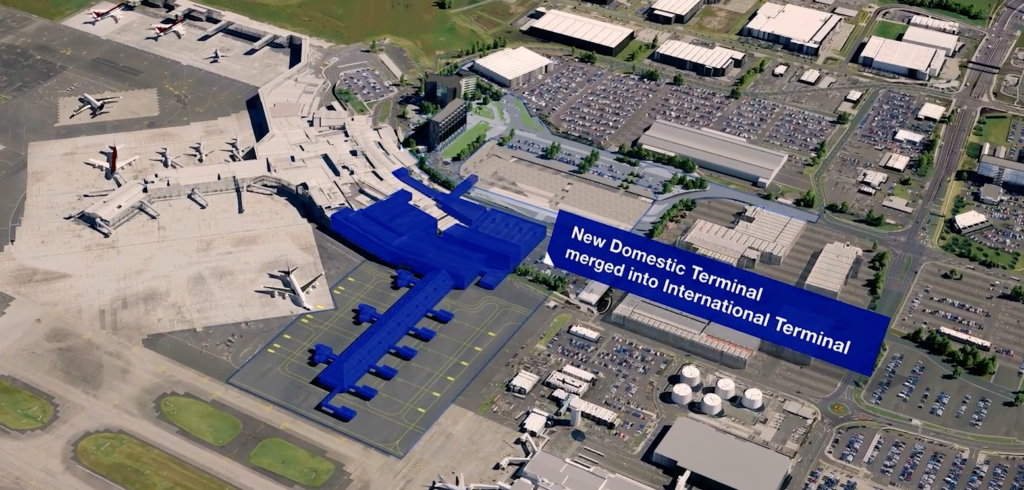Auckland Airport in New Zealand has announced that it has received approval to move into the final stages of design for a brand-new domestic terminal that is to be integrated into its existing international terminal. This is part of a NZ$3.9bn (US$2.4bn) investment program – the single biggest redevelopment at the airport since it opened in 1966.
Following a decision in 2019, the Auckland Airport Board has given approval for the project to move into the final stages of design, with the construction program to take place over the next five to six years. This includes the circa NZ$2.2bn (US$1.37bn) combined terminal plus a number of other projects associated with that development. To support the development, the airport will employ 2,000 people at the height of construction.
Set to open between 2028 and 2029, the new combined terminal will add floor space across two levels to the existing international terminal building. The domestic terminal is intended to offer modern spaces, efficient passenger processing areas, improved bathroom facilities and faster baggage systems, as well as better connections between domestic and international travel and via public transport to the city. The facility is expected to cut domestic jet to international transfer times to a five-minute indoor walk. There will be faster links to public transportation via the new Transport Hub that is to be built on the doorstep of the international terminal. The airport will also provide new gates and other facilities to help airlines smooth and speed-up turn-around times.
A new check-in experience will also be installed to provide state-of-the-art facilities for both domestic and international travelers, including the ability to check in and store baggage at any time throughout the day. Furthermore, smart baggage systems will be implemented to save time and reduce stress at either end of a flight.
The wider integration program includes upgrades to airfield pavement and underlying utilities. The combined terminal will serve the larger and more efficient domestic jet aircraft flying to and from Auckland to New Zealand’s other main centers, alongside international operations. The integration program will also enable Auckland Airport to carry out key upgrades on the airfield to ensure the airport remains resilient. Along with ground power units for aircraft, the upgraded airfield surrounding the new combined terminal will provide charging for electric ground-handling equipment and vehicles. Design and construction materials for the combined terminal will be selected to reduce the building’s carbon footprint as much as possible, alongside a focus on waste minimization and water efficiency.
While the new combined terminal is under construction, domestic travel will continue to operate from the existing domestic terminal. Regional turboprop flights, those traveling to smaller town centers, will remain in the existing domestic terminal for now, with Auckland Airport currently consulting with major airlines and the Board of Airline Representatives (BARNZ) on the future location for regional travel. Auckland Airport has been consulting with its major airline customers since May 2011 on the replacement for the aging domestic terminal.
Auckland Airport is due to set aeronautical prices for the remainder of the price-setting event for 2023 to 2027 financial years (PSE4) by the end of June this year, following airline consultation. Because of the scale of the project and the time it will take to deliver, the airport’s terminal integration program will straddle the next two pricing periods, together spanning 2023 to 2032. Aeronautical price consultation for the financial years from 2028 to 2032 (PSE5) will be completed by June 2027.
Carrie Hurihanganui, chief executive of Auckland Airport, said, “This is all about building the gateway Auckland and New Zealand need. A new domestic terminal integrated into the international terminal will make Auckland Airport fit for the future, providing a much-improved experience for travelers – something they’ve clearly and repeatedly told us they want. In short, renovations just won’t cut it anymore.
“We recognize that in today’s environment price changes are challenging. As we step forward, we are ambitious but mindful of cost, ensuring our infrastructure program is fit for purpose. We believe the value in creating the resilient gateway that Auckland and New Zealand need is worth the money invested. Kicking infrastructure investment down the road would not be in New Zealand’s best interests. History shows it will not get any easier or cheaper. To make sure every journey is a comfortable one until the new domestic terminal opens, we will be upgrading and renovating traveler facilities at the current domestic terminal, including bathrooms, helpdesks and dwell spaces.”
Patrick Strange, chair of Auckland Airport, commented, “This is a major investment for Auckland Airport, one which we have been working toward for many years. The domestic terminal is almost 60 years old and needs replacing. It’s nearing capacity and it’s no longer fit for purpose and hasn’t been for some time. If it wasn’t for the Covid-19 pandemic, we would already be well underway with its replacement.
“Every dollar we spend on this infrastructure will serve travelers, airlines and New Zealand well into the future. It will ensure New Zealand’s main gateway is resilient and sustainable, supporting airline ambitions for a low-carbon future and strengthening our infrastructure in the face of increasingly severe weather events due to climate change.”
For more key construction and architecture updates from the passenger terminal industry, click here.

